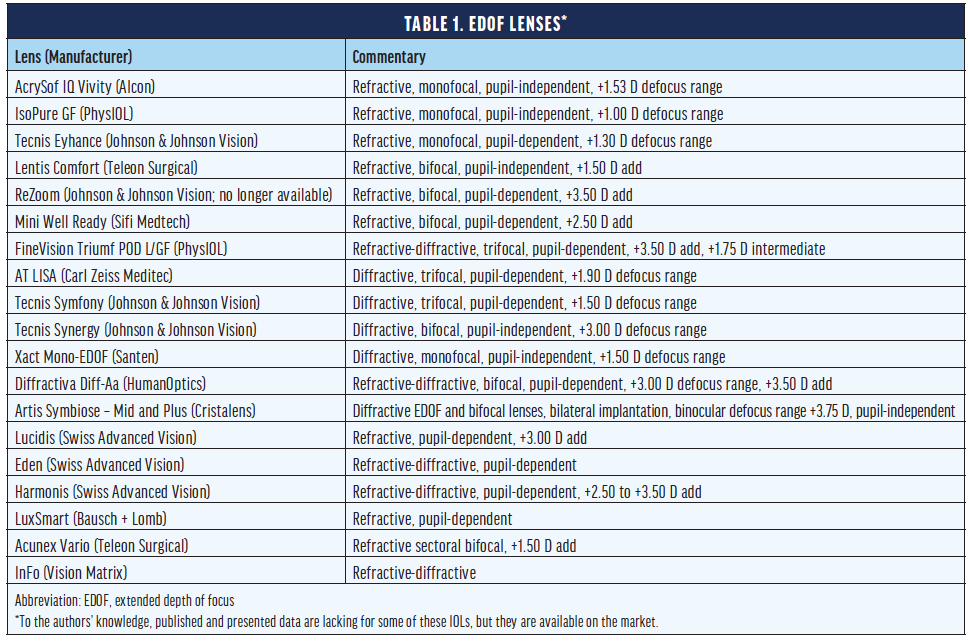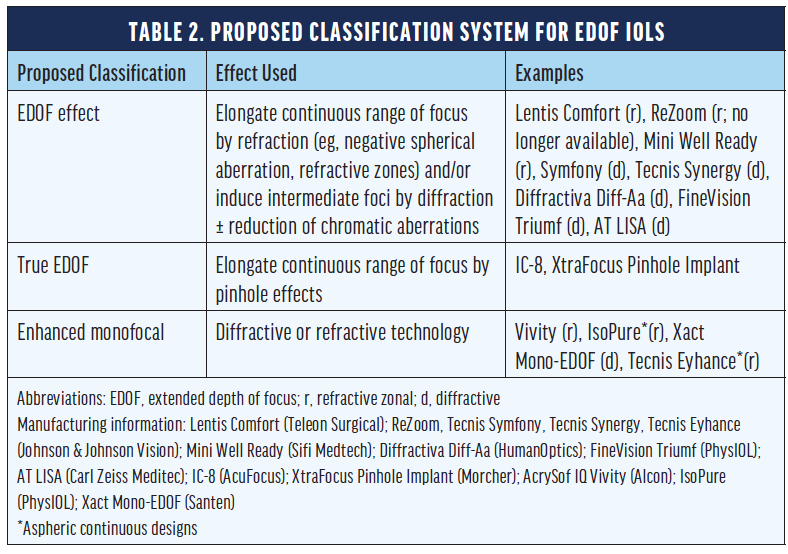

Long gone are the days when cataract surgeons were content to choose a model and power of a standard monofocal IOL for each patient. The refractive aspect of cataract surgery and refractive lens exchange currently consumes a majority of the preoperative consultation.
With diffractive bifocal IOLs, patients can benefit from the simultaneous correction of distance and near visual acuity.1 Trifocal IOLs add intermediate visual acuity into the mix.2 The introduction of toric versions of multifocal IOLs allows patients with preexisting corneal astigmatism to be candidates for presbyopia-correcting technologies as well.
A drawback of multifocal IOLs, however, is that patients often experience unwanted photic phenomena such as glare postoperatively. Several manufacturers have developed extended depth of focus (EDOF) and extended range of vision (EROV) IOLs in response to this concern. Their goal is to provide the advantages of multifocality without the inherent disadvantages of splitting and sharing the light entering the eye across several foci. The American National Standards Institute defines EDOF IOLs as “implants that provide increased depth of focus compared to a monofocal IOL, with statistical superiority for photopic intermediate vision and noninferiority for distance vision.”
Confusion over what EDOF and EROV lenses actually offer and where they fit in the armamentarium has ensued. This confusion has been exacerbated by the efforts of some manufacturers to present their products in the best light while disclosing as little technical information as possible on the optical principles on which those technologies are based. Compounding the problem is that EDOF and EROV IOLs are often positioned as solutions to presbyopia, yet their near vision performance is insufficient to allow an eye corrected for distance vision not to require spectacle correction for near vision.
This article shares our efforts to demystify the category of EDOF and EROV IOLs.
WHAT THIS CATEGORY INCLUDES
The terms EDOF and EROV encompass a wide variety of optical principles, including a pinhole effect (ie, IOLs with a reduced pupillary aperture), diffractive IOLs, and aspheric and/or multizone refractive IOLs (Table 1). For this reason, we believe a change in the terminology used for this class of lenses is required—a position that a growing number of cataract and refractive surgeons support internationally (see “Let’s Speak Lenspeak” and “A Surgeon’s Guide to Proper Terminology and Concepts,” two other articles published in this issue). To this end, we have developed a classification system that groups lenses according to their theoretical optical principles (Table 2).3


A close review of the nomenclature being used with EDOF and EROV IOLs makes it clear, for example, that pinhole and aspheric lenses do not belong in the category of multifocal IOLs. On the other hand, diffractive IOLs by design provide distinct foci linked to the diffraction orders that the diffraction of light generates, so these lenses fall under the umbrella of multifocal IOLs.
There is more ambiguity with alternative multizonal lens designs, which can be symmetrical, such as the AcrySof IQ Vivity (Alcon) and Tecnis Eyhance (Johnson & Johnson Vision), or asymmetrical, such as the Lentis Mplus IOLs (Teleon Surgical). The presence, however, of abrupt variations in curvature creates distinct focal zones, which bring the optical principles closer in line with those of multifocal implants, albeit with a smoother distribution of light energy between different focal distances. Fundamentally, discontinuity on an optical surface is potentially the origin of a light-diffraction mechanism, so even lens designs that feature plateau rings or steps may fit this description.
Confounding matters is a coming influx of so-called enhanced monofocal or monofocal plus lenses that do not quite qualify as EDOF IOLs according to the definition set forth by the American National Standards Institute.
A REQUEST TO MANUFACTURERS
In order to mitigate confusion, manufacturers should both clearly disclose the optical principles each of their IOLs uses to reduce patients’ spectacle dependence and avoid the use of ambiguous marketing language. Light is light. It is either diffracted or refracted with forward propagation through a medium.
We propose categorizing premium IOLs into three groups:
- Group No. 1: Pinholes (true EDOF);
- Group No. 2: Aspheric (enhanced monofocal/monofocal plus); and
- Group No. 3: Multifocal (EDOF effect), which can be subdivided into diffractive and refractive designs.
In terms of expected performance, manufacturers should state the distances for which a given IOL provides spectacle independence.
1. Gatinel D, Houbrechts Y. Comparison of bifocal and trifocal diffractive and refractive intraocular lenses using an optical bench. J Cataract Refract Surg. 2013;39(7):1093-1099.
2. Gatinel D, Pagnoulle C, Houbrechts Y, Gobin L. Design and qualification of a diffractive trifocal optical profile for intraocular lenses. J Cataract Refract Surg. 2011;37(11):2060-2067.
3. Rampat R, Gatinel D. Multifocal and extended depth-of-focus intraocular lenses in 2020. Ophthalmology. September 25, 2020. doi:10.1016/j.ophtha. 2020.09.026


